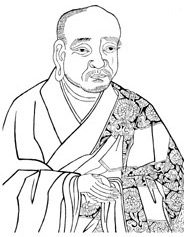
The Awakening of Faith in the Mahayana is traditionally attributed to Asvaghosa (c. 80-c. 120 CE), an Indian Buddhist philosopher. The text, however, is regarded in academia as a Chinese apocryphon written in 6th century CE. Understood in this way, it is seen as an attempt at making sense of the various teachings that had recently entered China, paralleling a similar undertaking by Zhiyi (538–597), the founder of the Tiantai school.
This still little known text amounts to a re-interpretation of Indian Mahayana in the light of China’s native culture, which had never been touched by the philosophical mind of Brahmanism. Although several generations of translators had produced a wide range of Chinese versions of Indian sutras, this had been a piecemeal work that had given rise to apparent contradictions, given the different Indian schools that wrote them. In addition, while it was felt that the closest parallel to Buddhism was to be found in Daoism, there was in the latter an emphasis on spontaneity that had to be experienced rather than studied in texts, least of all, texts with several thousand lines!
The Awakening of Faith is succinctly referred to as the text that conflated the concept of Buddha-nature found in the Tathagatagarbha tradition, and Yogacara’s concept of alaya-consciousness, and as such, it is regarded as an antecedent of Original Enlightenment Thought. It also goes some way in throwing light on differences between Indian and East Asian Buddhism such as the focus on achieving awakening in this very lifetime, not after many lifetimes, and the central role given to the phenomenal – the many – in contrast to an emphasis on the One emptiness of the Whole, which had mimicked the emphasis on Brahman as a Higher Being found in India.
After a rather lengthy introduction, the main text of the Awakening of Faith, starts in Part Three – Chapter One as follows:
Revelation of True Meaning: One Mind and Its Two Aspects
“The revelation of the true meaning [of the principle of the Mahayana can be achieved] by [unfolding the doctrine] that the principle of One Mind has two aspects. One is the aspect of Mind in terms of the absolute (tathata; suchness), and the other is the aspect of Mind in terms of phenomena (samsara; birth and death). Each of these two aspects embraces all states of existence. Why? Because these two aspects are mutually inclusive” (Hakeda translation).
Chinese Buddhists saw a contradiction between the claim that our mind was the womb of our potential Buddhahood, and the Yogacara description of the alaya-consciousness as the locus of the illusory view that caused our endless suffering.
In Jacqueline Stone’s words, the Awakening of Faith “represents part of a larger attempt on the part of Chinese Buddhists to clarify the relation between the mind, understood as originally pure, and ignorance.” How could “the originally pure, enlightened mind intrinsic to all sentient beings, conceptualized as the ‘womb’ or ‘embryo’ of Buddhahood” [Tathagatagarbha or Buddha nature] which “in ordinary worldlings, … is the potential for enlightenment and in Buddhas, the fully realized truth or the dharma-kaya” also be the source of illusion and suffering, in other words, the unenlightened view of samsara?
“Within the Indian Mahayana, this question had been addressed most explicitly by the Yogacara doctrine of the alaya-vijnana or “store-consciousness.” This level of mind is imagined as the repository in which all past experiences, wholesome and unwholesome, pure and defiled, are deposited as “seeds” (bija) that shape future deeds. Ignorance has its source in the defiled seeds that have accumulated in the store consciousness since the inconceivably distant past.” Whereas we usually believe our consciousness to mirror things existing in a world perceived as external to us, this is not so. Karmic seeds arising from the alaya-consciousness cause us to “edit highlights” in our field of perception, i.e., select what is of interest to us, or threatens us or disgusts us, thereby distorting our view of the world. We do not realise that what we see is not the world outside, but our reorganisation of it, manufactured in the alaya-consciousness. It had been believed that the extirpation of the defiled karmic seeds was a process that required many successive lifetimes.
Stone then writes that “many Chinese Buddhists of the Sui (581-617) and Tang (618-907) dynasties were dismayed by so remote a vision of liberation and sought to reimagine it in more accessible ways. In approaching the problem, the Awakening of Faith subsumes the alaya-vijnana concept within that of the tathagata-garbha by redefining the former as none other than the one pure mind as perceived through unenlightened consciousness.” This last statement is key because it amounts to a claim that the alaya-consciousness is not different from the pure mind, and it is only our unenlightened minds that see it as impure, thereby opening up the “ever-present possibility of transforming that mind into the mind of awakening.”
Source:
Jacqueline I. Stone – Original Enlightenment and the Transformation of Medieval Japanese Buddhism
